- Home
- Encyclopedia
- Bob David’s War: A Wyoming Soldier Serves In Fr...
Bob David’s War: A Wyoming Soldier Serves in France
Bob David was a troubled kid who grew up in a well-to-do family on a ranch and later in two small towns in Wyoming. He never liked the life of privilege, though. Something about it made him angry. When the chance came, leaving home in 1917 to fight in World War I was a relief to him.
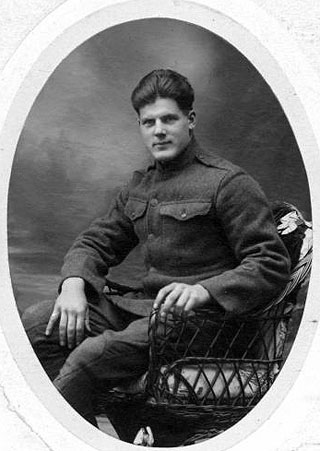
In France, he got hurt in the war and spent months in hospitals recuperating. When he was well enough to travel again, the U.S. Army ordered him home. But all he could think of were his friends, still in combat. All he could think of was how to sneak back to the war.
As an adult, Bob became a writer and self-taught historian. He kept regular diaries. These along with letters he saved were the source of at least two autobiographies, one of them more than 1,200 typed pages long. They paint a vivid picture of Wyoming and the West in the early 20th century, and of World War I. But behind the picture he was painting he left an image of another war, which, if a little harder to see, is no less real. It’s a picture of his war with himself.
Early life
Bob David was born in 1894, probably in Wisconsin, to parents he never knew.
When he was 3 years old, he was adopted from an orphanage near Milwaukee by Edward T. David, and Mary Beebe David, who took him back to their ranch home on Boxelder Creek, between Glenrock and Douglas, Wyo. Ed David managed the ranches that belonged to the Carey family. A person could ride the 40 miles from the SO Ranch where the Davids lived to the CY Ranch just west of Casper, Wyo. and never, it was said, leave Carey land.
Edward David had come to Wyoming from upstate New York in the 1880s to try ranching. He was a cousin of Louise David Carey. Her husband, Joseph Carey, would soon be elected one of the state’s two first U.S. senators. This connection led to Ed David’s job and the big sandstone house on Boxelder Creek that went with it. It also linked the Davids to the highest levels of Wyoming society; David Street in Casper is named for Edward David.
Bob’s mother, at least, appeared to enjoy these links. But Bob never felt confident that his parents really wanted the benefits to extend to him. And his parents, at least in his recollection, were not happy together. Years later he described his father as “henpecked by a beautiful woman.”
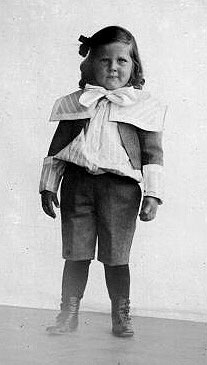
When Bob was 5 and a half, his father left ranching and went into business with another man in a general store in Wheatland, Wyo. The family moved there.
Bob was the Davids’ only child. He was 7 when he first learned he was adopted. He had a terrible time trying to believe this, and his behavior changed for the worse. He stole money from his mother’s purse. He also wet his bed at night and, with increasing frequency, wet the trousers of the fancy Lord Fauntleroy suits that his mother made him wear during the day.
All his life, Bob remembered that he felt betrayed and lied to because his parents kept his origins secret from him as long as they did. He had a stormy, troubled youth often in conflict with his parents and other people, and the adoption question seems to have been at the center of that storm.
When he was 8, his parents sent him to Ridley College, a boarding school for boys in Canada near Niagara Falls. Bob hated it. The older boys brutally hazed and beat the younger ones. Every summer Bob returned home full of secrets he could not tell and resignedly headed back to the school in the fall.
The first year he was there, for example, one of the school’s two main buildings burned to the ground. The fire was the first of three that occurred in his vicinity in his youth, and that he mentions almost offhandedly in his 1,200-page autobiography. There is no way to tell if Bob was connected with the fires. Still, a reader cannot help but suspect that, since he took the trouble to write about them 50 years later, he might have been leaving hints, even if inadvertently, to his complicity.
He spent most of 10 years, from 1902 to 1912, at Ridley, visiting relatives in upstate New York at Christmas. Once, he went with friends on a camping and canoe trip in the woods of Ontario. One night while they were camped on the shore of a lake, an abandoned cabin nearby burned down.
He returned to Wyoming every summer. The summer before his ninth grade year, some local boys taunted him about not knowing who his real parents were. He confronted his mother, who said the boys were right, that he was adopted but that she and Ed David “love you as we would our own.”
Again, he felt betrayed and lied to—and separate from everything his parents liked. “I had always felt as an alien toward the things which meant most to the Davids,” he remembered years later, “money, important people, prominence. … Now, more than ever before I was an outcast … love and affection was a myth as given me by the Davids. I was lost.”
Afterward, Bob and his father went on a fishing trip in the mountains west of Wheatland. Next morning, a rancher rode up to their camp to tell them the general store in Wheatland had burned, taking an entire half block with it. That fall, Ed David bought a hardware store and lumberyard in Douglas, Wyo., and the family moved there.
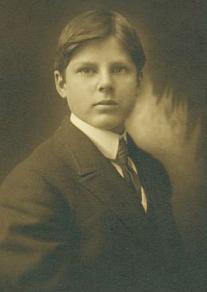
In the spring of 1910, Bob’s parents took him with them on a long trip to Italy, France, England and Scotland. In the spring of 1912, Bob graduated from Ridley. Instead of attending a university like most of his classmates, he returned to Douglas to work in the hardware store. He hated it. His father paid him little and he quarreled often with his mother.
From job to job
He took a job at a Douglas brickyard next. Each evening he returned covered in brick dust, washed in a bath drawn by servants, put on a tuxedo and went downstairs to eat a formal dinner with his parents.
After five months at the brickyard he left for the Northwest, where he worked in logging camps in Oregon and Washington. The following year he bounced back to Wyoming for a job on a railroad construction crew. In the fall of 1915 he enrolled at the University of Wyoming in Laramie, completed his freshman year there, and moved to Denver the following spring. There he worked more jobs, and finally a better-paying job managing a lumberyard in the mining boomtown of Nederland, Colorado.
Back in Denver one day in June 1916, Bob found himself idly watching a man called the Human Fly climb the walls of the Colorado State Capitol. The beat and blare of the drums and brass of a marching band floated down the breeze from Broadway, a few blocks off. Bob followed the band, its flags waving, to a building on Champa Street. Fifteen minutes later, having hardly given the matter a thought, he emerged as a soldier in the Colorado National Guard. He had enlisted to fight Pancho Villa on the Mexican border.
The Colorado National Guard
As part of the widespread chaos of the Mexican Revolution, by now in its fifth year, Gen.Villa’s forces had raided American towns and ranches in Arizona and New Mexico several times. President Woodrow Wilson had ordered U.S. troops to the border to chase the Mexican guerillas.
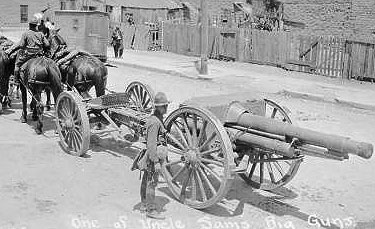
Bob was assigned to the artillery--Battery B of the Colorado National Guard. These men trained in the deserts of New Mexico and west Texas. Bob excelled at handling the mules that pulled the wheeled field guns assigned to his unit. While regular U.S. Army troops chased Villa into Mexico, the Guard stayed on the American side and saw no combat. But Bob got used to army life, and liked it. He liked the comradeship, and the feeling of being part of a cause, of something large and important.
In March 1917, the troops were sent home, and Bob returned to Denver. But most of the troops did not expect to stay home long. World War I had broken out across Europe in the summer of 1914, and then settled into a long, fierce stalemate. In April 1917, the United States entered the war, too—and the Guard called Bob back into the service.
Training for war
By this time, artillery batteries from the Colorado National Guard had merged with infantry units from the Wyoming National Guard to make the 148th Regiment of Field Artillery of the U.S. Army. The regiment trained in Colorado, North Carolina and at Camp Mills, on Long Island outside New York City.
Wyoming would eventually send about 12,000 young men into the armed services during World War I. About three-fifths of these were drafted and the rest, like Bob, enlisted. Out of 4.8 million Americans in the armed services in the war, 125,500 were killed. Of the Wyoming servicemen, 468 were killed and 881 wounded.
Camp Mills was a huge, muddy place, full of soldiers living in row after row of canvas tents. Military biplanes from a nearby airfield buzzed constantly overhead. Enterprising soldiers smuggled liquor in suitcases into the camp for resale. Brawls were common.
Bob’s Brooklyn grandmother and aunts, his mother’s relatives, visited from time to time. Once he returned to camp to find his aunts, Nellie and Jennie, sitting on a bunk in a tent among a crowd of soldiers “darning socks, patching pants, and knitting up holes in sweaters for the whole Battery …” Bob remembered years later. In December, bad weather forced the closing of Camp Mills. The regiment moved across New York Harbor to live in heated wooden barracks at Camp Merritt in New Jersey.
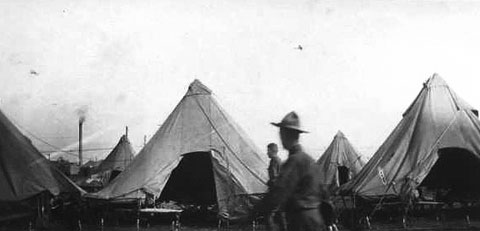
Bob was promoted from corporal to sergeant. Though he was still an enlisted man, and thus subject to the whims of officers, he now had more responsibility.
The promotion could have come a lot sooner, his captain told Bob, if Bob had let it be known he was related to the Careys. He replied bluntly he’d assumed it wasn’t right for family connections to play any part in army promotions. “Then I saluted and left,” he recalled years later in his long memoir. “Somehow, I never was very popular with the captain.”
Dangerous crossing
Late in January 1918, the 148th shipped out for Europe. They boarded the British steamship Baltic, a former passenger liner. They took on coal in Nova Scotia, and then far out at sea joined a convoy of 11 other troopships escorted by a British cruiser. The food was bad. The men were seasick. Across the Atlantic, the ships zigged, zagged and changed speeds often to confuse any German submarines that might be hunting them.
Off the west coast of Scotland, eight British destroyers joined the American convoy as the ships entered the most dangerous waters of all—the narrow strip of sea between Scotland and Ireland, where German submarines would have the easiest time finding them.
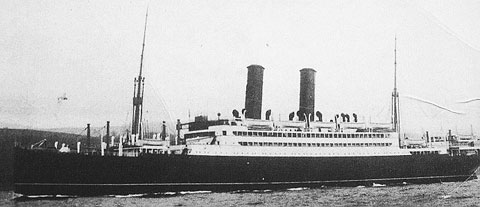
As the convoy steamed south, the Tuscania, right behind the Baltic in the convoy line, was torpedoed. The ship sank four hours later. Most of the 2,000 American troops and 300 British sailors made it to shore safely, but an estimated 230 died. Bob and his comrades, shaken by what they had witnessed, arrived at the port of Liverpool. A few days later, at Southampton, they boarded another ship, which crossed the English Channel to France. The ship landed at Le Havre, on the coast of Normandy.
Big guns
Almost immediately Bob down with scarlet fever. In those days, there was nothing to do with the sick but separate them from well people—and so Bob was left behind when his regiment boarded the train south to camps near Bordeaux for more training. This wasn’t the last time Bob would be separated from his friends. As they marched away, he lay in his blankets on a hard floor and listened to cold rain hit the tent. “I have never been quite so lonesome since,” he remembered, decades later.
After a month or more in hospital, Bob was well enough to be given responsibility for 110 men as they traveled by train across France to Bordeaux. There he found the 148th regiment and his buddies from Battery B at last, at a camp called La Courtine.
The Wyoming and Colorado artillerymen were learning to use French-made guns that could shoot a 98-pound explosive shell 10 miles and hit a target with pinpoint accuracy. The barrels were 155 millimeters—about six inches—in diameter. Much too heavy to be pulled by mules, the guns were pulled by tractors or sometimes trucks, one for each gun.
On weekends, Bob bicycled among the villages, eager to make friends and use his schoolboy French. Because his last name, David, is such a common last name in France, it seemed that nearly every village had a family of “cousins.” Bob, the adopted boy, was happy to be welcomed into their homes.
The front
On July 3, 1918, orders came to load the guns, gear, trucks and tractors onto a train. The colonel of the regiment and the major had already gone ahead. The next morning, the artillerymen boarded a train for the long trip to the front. They arrived near the village of Montmirail, northeast of Paris, shortly before daylight on July 5.
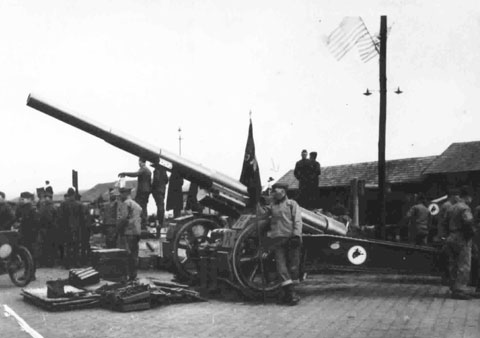
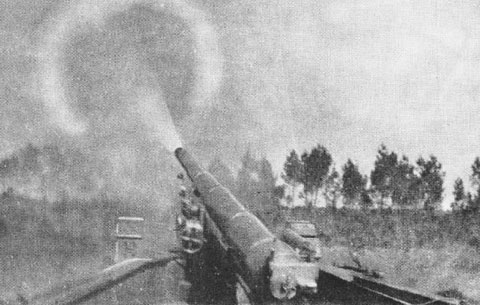
“Everything was still in darkness,” Bob recalled 35 years later, “and we could hear the dull booming of the front away over northward of us, sounding like a thousand cattle cars filled with frenzied steers kicking at the sides.”
The war in Europe had started in the summer of 1914. In September, the Germans drove toward Paris, but following a six-day battle in which half a million men were killed or wounded, the French and British armies stopped the Germans at the Marne River, northeast of the capital. Each side dug deep, defensive trenches. Soon the front stretched 475 miles from the Swiss border through northeastern France and across Belgium to the English Channel.
From time to time, one side or the other would order long artillery bombardments of the trenches on the other side. When the big guns ceased firing, foot soldiers were ordered out of the trenches and “over the top” to charge the other side, with bayonets fixed to their slow-firing, bolt-action rifles.
There, in a no-man’s-land between the lines of trenches, they were caught in barbed wire and cut down by thick machine-gun fire from their enemies. The defenders, therefore, always enjoyed the advantage. The front never moved more than 50 miles one direction or the other.
This stalemate was nearly four years old in the summer of 1918, when American troops began arriving in large numbers.
Accident and chance
The men of Battery B set up their four French 155s on the edge of a thicket on the road leading from the village of Chateau-Thierry north to Montmirail. The next morning, a cart came up the road, pulled by a mule. Two Frenchmen were driving the cart, and it was full of hand grenades. The Americans were about to begin firing the 155s, and feared the big guns’ shock waves could set off the grenades in the cart. In his schoolboy French, Bob warned them not to pass. But the men in the cart kept going, passing the number one gun just as it was fired. All the grenades exploded.
There was nothing left of the cart. There was a deep hole in the middle of the road. At the bottom of the hole were the two men’s heads. The mule’s carcass was blown into a tree nearby, where it remained for several weeks. Shortly after the explosion, one of the Americans took a grenade into the woods and hit it with a pickaxe to see how it worked. It worked fine and blew him to pieces. Bob later wrote about these things without including a word on how they made him feel.
Many of the moments Bob remembered clearly mixed murderous terror with the deep thrill of finding himself alive afterward. One night a shell fired from one of the 155s came out wrong, and went wobbling and howling across the sky. The artillerymen could only hunch down and hope it wouldn’t fall on them—or on American or French infantry soldiers ahead of them.
Then, blam! Out of the blackness miles away came a big explosion, then more bangs, blams and rockets going off haphazardly for more than an hour. The next morning, an ecstatic French general galloped up on a white horse to tell them they’d struck a German ammunition dump the French had been trying to find for weeks. The 148th won a medal. When, at the ceremony, the French general pinned the medal on the regimental flag, not a single American cracked a smile at winning a medal for a completely unplanned accident.
Spies, skulkers, and barrages
The trenches at the front were not always continuous. German soldiers could sneak through the spaces between the trenches at night, kill Americans, steal their uniforms and cause more trouble behind the lines. Bob called them “spies and skulkers.” One night, while he was camped in the thicket behind the big guns, Bob heard a noise. Quietly, he rounded up some men, and then led them loudly through the woods, driving the spy they discovered ahead of them. “[A]s he reached the moonlight I fired, as did sixteen others,” Bob remembered. The spy wore an American uniform, but a German helmet. Inside it, he’d stenciled his name, Peter Misner III. The Americans buried him. Bob never knew if any of the 17 bullet holes in the corpse were from his gun, but he hated and feared guns after that, he says, and never fired another.
Small guns—rifles or pistols—he must have meant, because the war continued and Battery B’s big guns kept firing. Big German guns kept firing, too. Sometimes the shells contained poison gas. The men pulled on gas masks as the barrage began. The masks were hard to see out of, sweaty and snotty inside, and they were thick and muffled sound. The long barrages were terrifying, no matter if gas was used or not. All the soldiers could do was take cover.
“I have sunk my fingers to their lengths in the soil, to the roots of the clinging grass,” Bob would write years later. The world heaved, roared and turned over, “and peace and love were far away, and I was a grain of sand on a great desert of earthquake….” Such experiences stayed with him for decades, and probably for the rest of his life.
Final German push
In the spring and summer of 1918, the Germans made a last attempt to win the war before all American power was brought to bear. In July 1918, the conflicts escalated into what became known as the Second Battle of the Marne. Late in July, German forces crossed the Marne, where the French and British stopped them nearly four years before.
One evening the Americans of Battery B found themselves out of shells for the big guns as a mob of gray-clad Germans came toward them over the nearest ridge. The officers issued rifles to the artillerymen. They waited, as the German infantry advanced. But at the last moment more shells—and American infantry—arrived from the rear and together they drove the Germans back.
That night, the men of Battery B aimed the guns toward the Dormans Bridge over the Marne, 12 miles away, hitting the bridge just as German reinforcements were crossing. All the next day, soldiers in Bob’s regiment continued to fire, laying down a continuous barrage along the far side of the Marne on Germans massing there. Newspapers reported the water ran red with blood.
The Germans were trapped by the river and the bridge they could not cross fast enough. A spotter from a hot air balloon used for reconnaissance told the men their shells were killing 100 Germans at a time now. Bob gave each of the soldiers on his crew a chance to jerk the lanyard that fired the gun, so each man could tell his grandchildren he had killed 100 Germans with a single shot.
Fighting was thickest for the Americans at Chateau-Thierry and in a forest north of there, Belleau Wood. About 30,000 Americans were killed or wounded. Even this late in the war, no one had figured out better tactics than to spend the lives of thousands to gain a little ground.
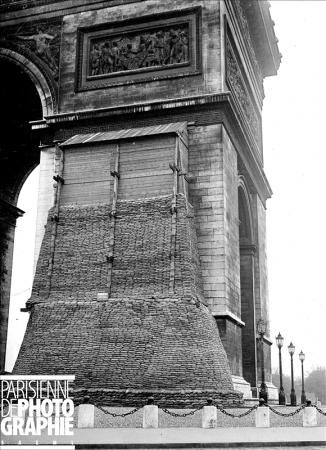
Injury
During the confusion of a night gas attack a few days after the Germans had been stopped, while the Americans fumbled in the dark for their masks and tried to get away from the poison fumes, Bob was kicked in the leg, hard, by one of his fellow soldiers.
Following his bout of scarlet fever months earlier in Le Havre, Bob developed varicose veins in his legs. It made them extremely vulnerable to injury. His veins swelled and thickened until they stood out like raised, ropy blue cords under his skin. After he was kicked, his leg started bleeding profusely.
He was put on a medical train and taken south to a hospital at Montpon, near Bordeaux. The surgeon told him after the operation he probably wouldn’t walk again without a cane or perhaps crutches. But Bob could not face such a bleak future and forced himself to walk as far and as often as he could. Eventually, he could walk around the ward on his own, though he still needed a cane for longer distances. After several weeks he was ordered to take a train to Bordeaux, and catch a steamship back to the States. For Bob, the war appeared to be over.
Crisscrossing France
But it wasn’t. Not yet. Bob’s war continued—but mostly in his mind. The rest of Bob’s war seems desperate, angry, inconclusive, a little crazy and not nearly as dangerous as his time at the front.
Though he’d been ordered home, he was eager to see his friends again. He went AWOL—absent without leave, potentially a criminal offense in the Army—and made his way back north toward the front. In Paris, he told the truth about his plans to a gruff American captain, who overlooked his offense and gave him a three-day pass.
Bob’s memories of Paris at that time turn almost dreamy. The staff at the swanky Hotel Splendide remembered him from 1910 when he stayed there with his parents, and let him stay this time for free. A beautiful young woman named Yvonne, dressed from head to toe in a chic outfit of robin’s-egg blue, led him on an adventure among the Apaches of Paris, fabled criminals said to have ruled the city’s underworld.
In a huge room, deep underground, they sat at long tables, drank and glared. But then Yvonne announced him, and for his uniform, or his injuries, they suddenly adored him. They drank toast after toast in his honor and showed him their war injuries, too. Bob never forgot their “glorious villainous faces,” or the sight of their “terrible wounds, livid with misery and torturous ache, but speaking of the incalculable heroism of those thieves, and robbers and murderers of the slums of Paris.”
Then, Bob’s long hunt for his friends from Wyoming and Colorado began in earnest. Traveling by train, ducking the military police, finding sympathy and treatment for his legs when he needed to in U.S. Army hospitals, the hunt took him to the front and then back yet again across France to Bordeaux.
Influenza
At Le Courneau, southeast of Bordeaux, a camp of flimsy, thatched-roofed barracks, Bob found himself in the middle of the influenza pandemic of 1918. The flu spread rapidly throughout the world and killed millions more people even than the war. (Wyoming, for example, lost 780 people to the flu pandemic, compared to 468 servicemen killed in World War I.)
At Le Courneau, men died daily. Each day a bulldozer lengthened a wide, deep ditch, and coffins, each of which contained the remains of an American soldier, were laid inside. Men who lost friends grew fearful and told stories. Flu germs, they said, were somehow breeding in the thatch. A man, cut open by the medics after his death, was said to have had blood as black as tar.
The unit at last
Bob did not catch the flu, this time, but his legs still needed daily treatment. He didn’t always get it. Back north near the front, at a little town called St. Dizier, Bob, with his dirty, unchanged bandages starting to smell, again found a sympathetic doctor. Then, outside, he heard a sergeant looking for men good at office work.
A new American push had begun in the Argonne, not far away, and smart men were needed to help run the war. Here was a job Bob knew he could do and be useful, while at the same time receiving regular care for his legs. He took the desk job. Now and again, he was sent to other towns with dispatches.
Late one afternoon, Bob was riding in a motorcycle sidecar on a road clogged with war traffic. The line of cars, trucks, mules, motorcycles and wagons slowed, and then stopped completely. As the day darkened the passenger car behind Bob’s vehicle turned on its lights. Bob heard someone calling his name. He recognized the voice—it was one of the officers from the 148th! He found his old unit and thus caught up with his back pay and his mail, but as the war was winding down he kept the desk job at St. Dizier.
Armistice and after
Finally the Germans could continue no longer, Kaiser Wilhelm II abdicated and an armistice ending the fighting went into effect at 11 a.m. on Nov. 11th—the eleventh hour of the eleventh day of the eleventh month of 1918.
St. Dizier filled with dancing and drinking soldiers and citizens, and later, as the drinking went on, the brawling began. Six Englishmen were killed that night in St. Dizier in fights with Americans, and 65 more were hurt. Bob remembered beating various heads in with a heavy-wire cafe chair, and after that his memory of the events was hazy. British and American military police arrived, gathered up the bodies, and dumped them by the edge of a road. Everyone was in a hurry to forget killing of every kind.
The next day, Bob let an officer talk him into helping to run the St. Dizier office through the end of the year, though Bob could have left for home at the time “as is your right,” the lieutenant told him.
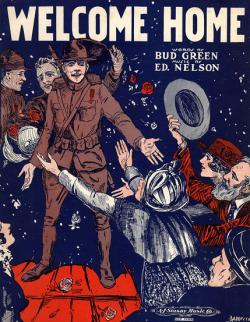 But when the new year approached, the same lieutenant told him he would have to stay on, as the office was about to be moved into Germany, as part of the Army of Occupation. Bob, who had been under no obligation to stay the first time, and who saw immediately that there was no way to know how long this new commitment could last, refused. The lieutenant was deeply angry but Bob, with the help of a medical officer, managed to elude the military police and escape on a train.
But when the new year approached, the same lieutenant told him he would have to stay on, as the office was about to be moved into Germany, as part of the Army of Occupation. Bob, who had been under no obligation to stay the first time, and who saw immediately that there was no way to know how long this new commitment could last, refused. The lieutenant was deeply angry but Bob, with the help of a medical officer, managed to elude the military police and escape on a train.
As he made his way south and then west across France toward a ship that would take him home, Bob befriended more pretty women and offended more officers. At Langres, he charmed Rosie Hagan, an Irish-American nurse; at Savenay on the west coast, near Nantes, it was Nurse Wood, the daughter of a general.
Bound for home
At Brest, on the northwestern tip of France, Bob boarded the American troopship Leviathan. He was bound for home at last.
The ship was so crowded the men had to eat standing up, and soon they, too, were dying of flu. Coffins were piled at the bow. On the second morning out, Bob awoke with the symptoms.
He sought help at the little clinic on board, where a young doctor made a show of pouring small amounts of liquids and powders into a big glass with measuring marks on the side, stirred everything together and gave it to Bob to drink. Go back to your bunk, the doctor told him, pile on the blankets and sweat through to morning. Then, said the doctor, Bob should shower, dress in clean underwear and clothes and sleep in a deck chair in the sun.
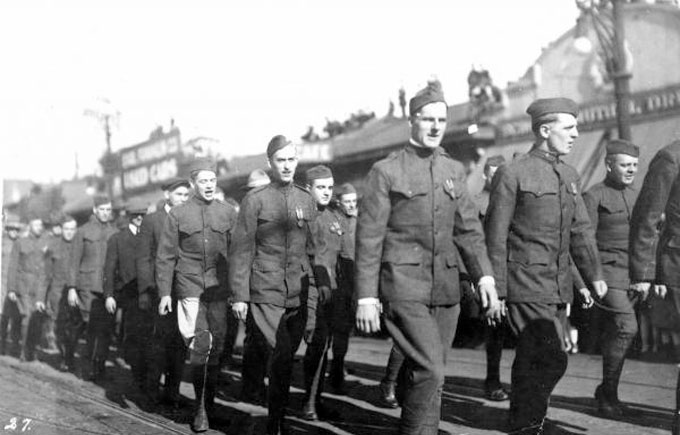
Bob followed directions and recalled the heavy sweating: “I could feel myself skidding inside my underwear every time I moved.” The next morning, cleaning up and putting on clean clothes, he was startled to find the old suit of underwear had turned black: “My sweat,” Bob was convinced, “had been black exactly like that soldier’s blood had been down in Le Courneau.”
A week or so later, the Leviathan entered New York harbor. Standing at the bow, soldiers who had thought themselves hardened by the war found their faces wet with tears. There was a big show from tugboats, with fireworks and hooting horns. Happy people thronged the docks at Hoboken, N.J., where the troops disembarked. Bob flung francs into the crowd.
Discharge trouble
After stops at army bases in New Jersey and Illinois, Bob was sent for final processing of his discharge at Camp Funston in eastern Kansas—the base where, ironically, historians now understand the international flu pandemic began in 1917. Bob felt he had to beat up a corporal who thought he could tell Bob what to do, and nearly came blows with three officers over the same question.
These soldiers had entered the army late and none had been to the war. Now, in peacetime, it was suddenly an army with little work to do and too many men to do it. Finally, a lieutenant gave Bob papers directing the medical corps to re-classify him for permanent duty at Camp Funston, where the officers—all with higher ranks but, with no war experience and thus, in Bob’s mind, no sense—could make his life hell.
Again, knowing where he’d get sympathy, Bob took the documents to the medical officer, a captain.
“I’ll be damned if the Medical Corps will be a means of revenge for any of these ‘ninety-day wonders,” the captain said, referring to the undertrained lieutenants. “It’s not the first time this has happened.” Later, the lieutenant who’d tried to reclassify Bob lost more respect when he ordered a few men to police the camp—that is, to pick up any trash lying around. The men ignored him, but when Bob asked that they do the same task, they went promptly to work.
The following morning, Bob got his discharge papers and tickets to Wyoming. At the train station, the lieutenant showed up again and threatened to keep Bob on the base.
But Bob felt he was on solid ground now. “‘Listen, you,’ I sneered my most villainous sneer,” he wrote years later, “‘I have my discharge in my pocket, and I am now off army reservations. I’m out of the Army, and I’m telling you this. Don’t you ever stick your nose into the state of Wyoming and let me know it, understand?’
“[T]he train to Denver was swift,” he adds, “and the future was bright before me.”
Uncertain homecoming
One of Bob’s war accounts ends there, in March 1919. But in another account, he recalls what happened a day or two later, when he got off the train in Douglas. Townspeople were so glad to see him, he remembered, and so many were greeting him that it took him an hour to walk the 12 blocks to his parents’ house. There, the greeting was much different:
"Father glanced up from his newspaper, and from his Morris chair said quietly, 'Glad to see you home. You can have the same room.' And, Mother called from the dining-room, 'Hurry and get your hands washed. We've been waiting for you.
No welcome. No love. They were acting true to form. I was home!"
Also, apparently, missing from this homecoming was his sweetheart, Edna Smith of Douglas—or if she did meet him at the train, Bob for some reason left her out of the account.
During his years away, as we have seen, he formed many other friendships with women—some of which he recalled years later as “hot"--and corresponded with them too. But during his last weeks in France, knowing he’d be home soon, he cabled Edna, asking her to marry him. A one-word answer came back: “Yes!”
The two had known each other since they were teenagers. Bob’s parents disapproved of her, Bob remembered, because she came from a sheep-raising family. Whether that meant their distaste was simply because the Smiths had less money than they, or because of old animosities between cattle people and sheep people, he doesn’t say. In any case, their opposition to a match with Edna almost certainly made the idea more attractive to Bob.
They married at the courthouse in Douglas on Aug. 16, 1919. Two strangers they’d met only moments before served as witnesses.
Bob’s father, Ed David, retired from business in 1919, and Bob’s parents moved to Denver. Perhaps they wanted to get away from Bob and the friction he created in their lives, or perhaps they just wanted a livelier social life than Douglas could offer. Whatever the reason, they stayed in Denver for the rest of their lives. Ed David died in 1949, and Mary Beebe David died in 1950.
Generous gift
Bob and Edna raised their daughters, Mary and Catherine, and he worked jobs that, like the ones he had in the U.S. Army, allowed him to use his administrative skills. In the 1930s, he was credit manager for Coliseum Motors in Casper. In 1940, he went to work for the Wyoming Sate Employment Office and ran the agency’s Casper operations for 20 years.
But his greatest passion was Wyoming’s history. His two books, Malcolm Campbell, Sheriff, published in 1931, and Finn Burnett, Frontiersman, published in 1937, are still valuable to scholars of Wyoming and the West. He published the first of these himself, and according to his account, sold 2,000 copies in about three years---a respectable amount.
The second book was published by the Arthur H. Clark Company, then of Glendale, Calif., a well-respected firm specializing in western history. Bob’s contract with the company specified that he would pay $500 to help defray the initial publication expenses, to be returned to him from the profits of later book sales.
But soon there was trouble. Bob traveled to California to proofread the book and draw up an index for it. But Clark found the index unsatisfactory, and had to hire an outsider to redo it. Books that Bob thought the publisher had sent him for free, for resale to offset the costs of his trip, were in fact given to him on consignment. And the $6 price was high, especially during a depression.
Ten years after publication, the publisher wrote Bob to say he still owed the company $344.12, part of the original debt, plus interest, less $87 in royalties. Bob may never have seen this letter, as it was sent to him at Coliseum Motors where he had not worked for seven years.
In 1952, Bob wrote a sharp letter to the publisher referring to their original contract and noting “[f]ollowing a prolonged illness, the contract … has now been discovered.” Bob demanded an immediate accounting of book sales by an outside accountant, and made a vague threat as to what might happened if he wasn’t satisfied with the answer. Clark staffer P.W. Galleher wrote back re-stating the debt, saying Bob had never answered the 1947 letter or many others sent to him over the years, and describing the company as one of a high reputation that for a half century had “enjoyed the friendship and confidence of many authors.” Bob never replied.
Still, out of his passion for history, he amassed a huge collection of his own notes and files along with a broad range of historic documents. In 1964, four years after retiring from the state employment office, he gave the collection to Casper College.
He may have had to put aside some old grudges to make the donation. In an editorial at the time of Bob’s death in 1968, the Casper Star-Tribune praised Bob for the gift, calling it “a vast collection of Wyomingana.” The editorial writer could not keep from adding, however, that Bob “frequently had been called upon by other writers for information for articles, and he occasionally expressed resentment that he should be expected to give freely of material that it had taken him many years to collect.”
Bob’s gift was an extremely generous and valuable one. Perhaps the date of that transaction, 1964, should mark the true end of Bob David’s war.
Resources
Primary Sources
- Bob David left a large collection of scrapbooks, notebooks, photographs and historic documents, plus notes and manuscripts of his own to Casper College in Casper, Wyo. These materials became the core of what is now the college’s Western History Center, located at the Casper College Library. Included in the David collection is a typed, untitled, unpublished autobiography, more than 1,200 pages long and keyed to references to Bob David’s huge photograph collection. He probably wrote it in the early and mid-1950s. The document, especially detailed about his youth, early manhood and years in the U.S. Army, is the main source of this account.
- Davis, Paul M. and Hubert K. Clay. History of Battery “C,” 148thField Artillery, American Expeditionary Forces. Colorado Springs: Out West, 1919. This book was written immediately after World War I by two soldiers who, unlike Bob David, stayed with the 148th in 1919 when the regiment was assigned to occupation duties in Germany. The book includes good foldout maps and a useful timeline of all the training, battles and other activities of the regiment throughout the war. The men of Battery C served in most of the same places as the men of Battery B, in which Bob David served. Copies are available in some Wyoming libraries. For more information, visit WYLDCAT, the Wyoming libraries database.
Secondary Sources
- Clark, Robert A. Introduction to Finn Burnett, Frontiersman, by Robert Beebe David. Mechanicsburg, Pa.: Stackpole Books, 2003, pp. v-xxi. In this new edition of Bob David’s second book, the grandson of the original publisher gives a fascinating account based on the company’s correspondence files of the rocky relationship between author and publisher at the time.
- Larson, T.A. History of Wyoming. Lincoln: University of Nebraska Press, 1965, 386-407. This respected book gives a good account of what was happening in Wyoming while thousands of the state’s young men were in France during the war.
- Mead, Gary. The Doughboys: America and the First World War. Woodstock, N.Y.: Overlook Hardcover, 2000. An excellent one-volume account.
- PBS. The Great War and the Shaping of the 20thCentury. “The Western Front in 1918.” Accessed 3/9/12 at http://www.pbs.org/greatwar/maps/maps_western.html. This is a series of animated maps of the last year of World War I from the PBS series about that conflict.
- Trail End State Historic Site. “Keeping the Home Fires Burning: Life on the Home Front During the Great War, 1917-1918.” “Over There.” Accessed 3/9/12 at http://www.trailend.org/keep-over.htm. Trail End State Historic Site was originally the home of Wyoming’s U.S. Sen. John B. Kendrick. The 1997-1998 exhibit listed above was built around the experiences of Kendrick family and friends in World War I
- U.S. Army Center of Military History. “The U.S. Army in World War I, 1917-1918.” Accessed 3/9/12 at http://www.history.army.mil/books/AMH-V2/AMH%20V2/chapter1.htm. A detailed account of the U.S. Army’s strategies, tactics and the politics of dealing with its allies during World War I.
- World War I, an Internet History of the Great War. “148thField Artillery Regiment, American Expeditionary Force.” Accessed March 9, 2012 at http://www.worldwar1.com/dbc/slideshows/148fa/sld001.htm.
- Wyoming Pioneer Association, Heritage Book Committee. Pages from Converse County’s Past. Casper, Wyo.: Wyoming Historical Press, 1986, pp. 142-143. A brief account of the David family in Douglas, which includes an account of Bob David’s wedding in 1919.
For Further Reading
- For more about the sinking of the Tuscania, see http://www.worldwar1.com/dbc/tuscania.htm for an overview and a firsthand account by Irvin S. Cobb of the Saturday Evening Post, who, like Bob David watched the sinking from the deck of the Baltic; For the Scottish angle see http://heritage.scotsman.com/topics.cfm?tid=1377&id=1630312006 and http://www.islayinfo.com/lord_robertson_islay_troopships.html.
- See also a rich assortment of World War I diaries and memoirs from the BrighamYoung University archives at http://wwi.lib.byu.edu/index.php/Diaries,_Memorials,_Personal_Reminiscences.
- On the great influenza pandemic, see http://www.pbs.org/wgbh/amex/influenza/sfeature/devens.html, for a vivid account from a doctor at a U.S. Army hospital in Massachusetts, who was exhausted and felt helpless as men died daily.
Illustrations
- The photos of Bob David—in uniform, in 1908 at Ridley, at the front of the parade in 1920, and in his Lord Fauntleroy suit—are from Bob David collection at the Casper College Western History Center Center. Used with permission and thanks.
- The photo of the wheeled guns on the Mexican border is from the Center for Southwest Research, University Libraries, University of New Mexico; Used with permission and thanks; see also their disclaimer on rights.
- The photo of Camp Mills, Long Island is from Mark Boyd’s website about his doughboy grandfather, Austin “Dusty” Boyd. Used with thanks.
- The photo of the Tuscania is from http://www.islayinfo.com/lord_robertson_islay_troopships.html, used with thanks.
- For more on the Wyoming national guardsmen in France with the 148th Field Artillery and their use of the bucking horse logo see the National Guard Association of the United States' website.
- The photo of one of the 155s firing is from a website on the 148th Field Artillery. Used with thanks.
- The photo of the sandbagged Arc de Triomphe, 1918, is from the excellent photo galleries at Parisenimages.fr.
- The "Welcome Home" sheet music is from the Special Collections Library at Duke University, featured by the Library of Congress.
